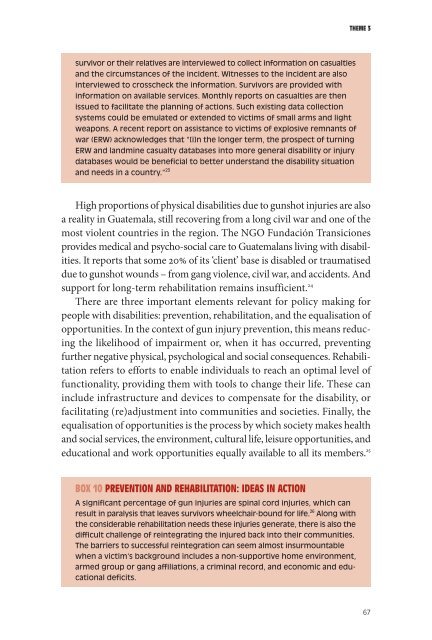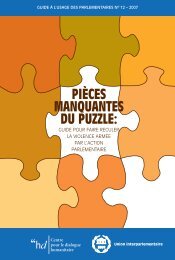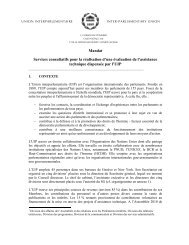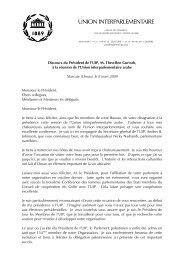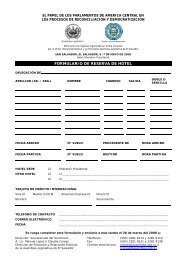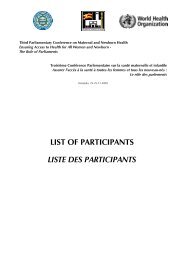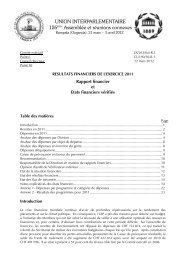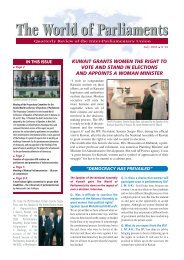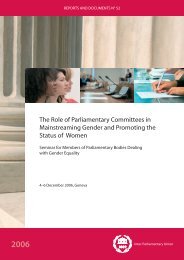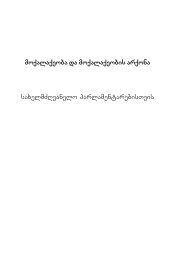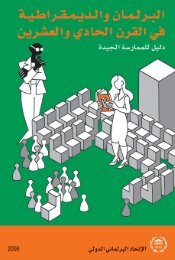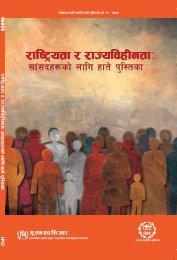MISSING PIECES - Inter-Parliamentary Union
MISSING PIECES - Inter-Parliamentary Union
MISSING PIECES - Inter-Parliamentary Union
Create successful ePaper yourself
Turn your PDF publications into a flip-book with our unique Google optimized e-Paper software.
THEME 3<br />
survivor or their relatives are interviewed to collect information on casualties<br />
and the circumstances of the incident. Witnesses to the incident are also<br />
interviewed to crosscheck the information. Survivors are provided with<br />
information on available services. Monthly reports on casualties are then<br />
issued to facilitate the planning of actions. Such existing data collection<br />
systems could be emulated or extended to victims of small arms and light<br />
weapons. A recent report on assistance to victims of explosive remnants of<br />
war (ERW) acknowledges that “[i]n the longer term, the prospect of turning<br />
ERW and landmine casualty databases into more general disability or injury<br />
databases would be beneficial to better understand the disability situation<br />
and needs in a country.” 23<br />
High proportions of physical disabilities due to gunshot injuries are also<br />
a reality in Guatemala, still recovering from a long civil war and one of the<br />
most violent countries in the region. The NGO Fundación Transiciones<br />
provides medical and psycho-social care to Guatemalans living with disabilities.<br />
It reports that some 20% of its ‘client’ base is disabled or traumatised<br />
due to gunshot wounds – from gang violence, civil war, and accidents. And<br />
support for long-term rehabilitation remains insufficient. 24<br />
There are three important elements relevant for policy making for<br />
people with disabilities: prevention, rehabilitation, and the equalisation of<br />
opportunities. In the context of gun injury prevention, this means reducing<br />
the likelihood of impairment or, when it has occurred, preventing<br />
further negative physical, psychological and social consequences. Rehabilitation<br />
refers to efforts to enable individuals to reach an optimal level of<br />
functionality, providing them with tools to change their life. These can<br />
include infrastructure and devices to compensate for the disability, or<br />
facilitating (re)adjustment into communities and societies. Finally, the<br />
equalisation of opportunities is the process by which society makes health<br />
and social services, the environment, cultural life, leisure opportunities, and<br />
educational and work opportunities equally available to all its members. 25<br />
BOX 10 PREVENTION AND REHABILITATION: IDEAS IN ACTION<br />
A significant percentage of gun injuries are spinal cord injuries, which can<br />
result in paralysis that leaves survivors wheelchair-bound for life. 26 Along with<br />
the considerable rehabilitation needs these injuries generate, there is also the<br />
difficult challenge of reintegrating the injured back into their communities.<br />
The barriers to successful reintegration can seem almost insurmountable<br />
when a victim’s background includes a non-supportive home environment,<br />
armed group or gang affiliations, a criminal record, and economic and educational<br />
deficits.<br />
67


